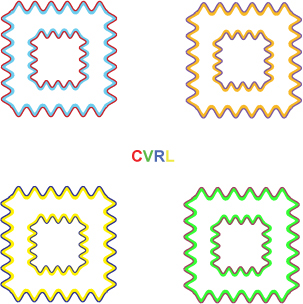

Lower panel of Figure 3.11.35 from Stockman, A., & Brainard, D. H. (2009). Color vision mechanisms. In M. Bass, C. DeCusatis, J. Enoch, V. Lakshminarayanan, G. Li, C. Macdonald, V. Mahajan & E. van Stryland (Eds.), The Optical Society of America Handbook of Optics, 3rd edition, Volume III: Vision and Vision Optics. New York: McGraw Hill.
Examples of the watercolor illusion.(Pinna, 1987; Pinna, Brelstaff, & Spillmann, 2001; Pinna, Werner, & Spillmann, 2003). Each square is outlined by a pair of juxtaposed sinusoidal contours. The color of the inner contour of each larger square and the color of the outer contour of each smaller square fill in the intervening space with a faint color (which looks like a watercolor wash). Inspired by a version of the watercolor illusion designed by Akiyoshi Kitaoka, see: http://www.psy.ritsumei.ac.jp/~akitaoka/watercolorillusionsamples.jpg
Pinna, B. (1987). Un effetto di colorazione. In V. Majer, M. Maeran & M. Santinello (Eds.), Il laboratorio e la città. XXI Congresso degli Psicologi Italiani (pp. 158). Milano: Società Italiana di Psicologia.
Pinna, B., Brelstaff, G., & Spillmann, L. (2001). Surface color from boundaries: a new 'watercolor' illusion. Vision Research, 41, 2669-2676.
Pinna, B., Werner, J. S., & Spillmann, L. (2003). The watercolor effect: a new principle of grouping and figure-ground organization. Vision Research, 43, 43-52.